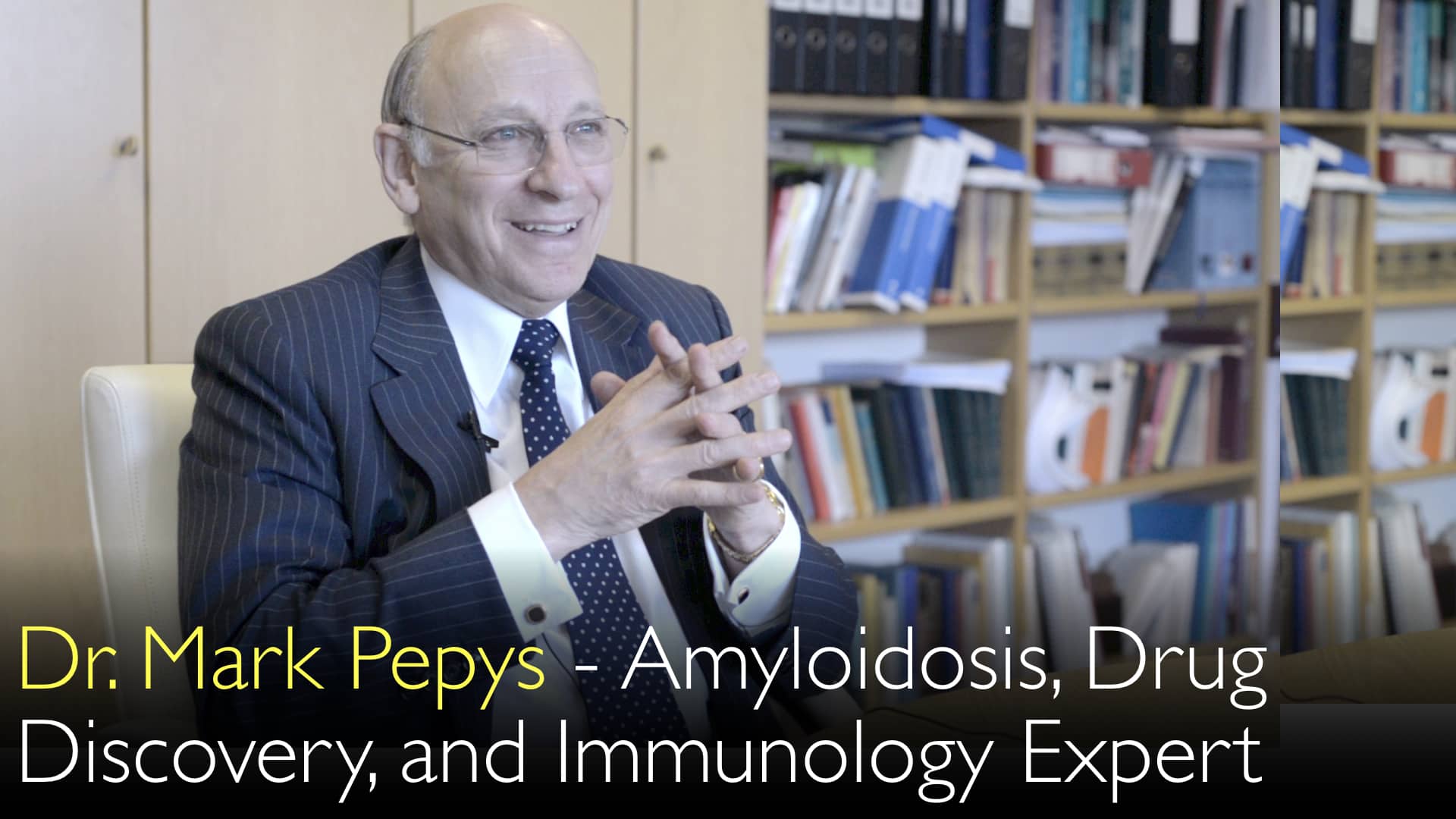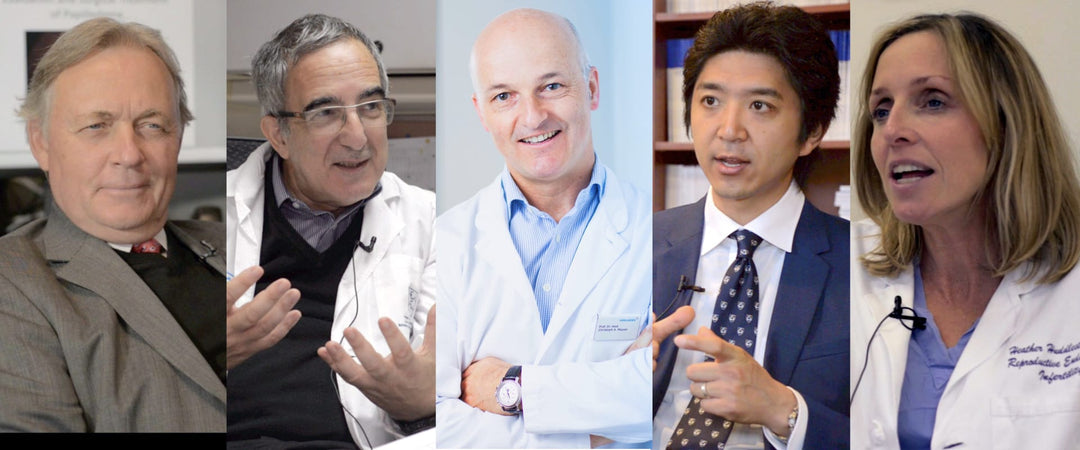Amyloidoosin tutkimuksen ja hoidon johtava asiantuntija, professori Sir Mark Pepys, MD, selittää amyloidoosin harvinaiseksi mutta vakavaksi sairaudeksi, joka johtuu poikkeavista proteiinikertymistä. Hän korostaa ajoitetun diagnoosin ratkaisevaa merkitystä, sillä viivästyneet toimenpiteet johtavat usein peruuttamattomiin elinvaurioihin ja kuolemaan kuuden kuukauden kuluessa. Tohtori Pepys kuvailee diagnostiikan haasteita, kuten sairauden harvinaisuutta ja monimuotoisia oireita, jotka sekoittuvat muihin sairauksiin. Hän esittelee kehittyneitä diagnostisia menetelmiä, kuten radioaktiivista merkkiaineimagointia ja sydän-MRI:tä, joita hän on kehittänyt ja joita käytetään Ison-Britannian kansallisessa amyloidoosikeskuksessa potilashoidon tulosten parantamiseksi.
Amyloidoosin ymmärtäminen: Diagnostiikka, hoito ja ajoitetun toimenpiteen kriittinen tärkeys
Hyppää osioon
- Mikä on amyloidoosi?
- Miksi amyloidoosin diagnostiikka on haastavaa
- Myöhästyneen diagnoosin seuraukset
- Erikoistuneiden amyloidoosikeskusten rooli
- Edistynyt kuvantaminen amyloidoosin diagnostiikassa
- Koko tekstitys
Mikä on amyloidoosi?
Amyloidoosi on vakava sairaus, jossa poikkeavat, liukenemattomat proteiinikuidut kertyvät kudosten ja elinten soluväliaineeseen. Kuten professori Sir Mark Pepys, MD, selittää, nämä proteiinifibrillit voivat muodostua eri esiasteproteiineista, mutta niillä on samankaltainen rakenne. Niiden kertyminen vääristää elinten rakennetta ja johtaa eteneviin, vakaviin toimintahäiriöihin.
Amyloidoosia on useita eri muotoja, ja jokainen luokitellaan fibrillejä muodostavan proteiinin mukaan. Monimuotoisuudesta huolimatta lopputulos on aina elinvaurio. Amyloidoosia pidetään harvinaisena sairautena, mutta se aiheuttaa noin yhden tuhannesta kuolemasta kehittyneissä maissa. Tohtori Anton Titov, MD, huomauttaa, että hoitamaton amyloidoosi on aina kohtalokas, mikä tekee sen tunnistamisesta ja hoidosta kriittisen kliinisen prioriteetin.
Miksi amyloidoosin diagnostiikka on haastavaa
Amyloidoosin diagnostiikka asettaa merkittäviä haasteita lääkäreille. Sairauden harvinaisuus tarkoittaa, että monet lääkärit saattavat kohdata vain muutamia tapauksia koko uransa ajan. Tämä vähäinen altistus alentaa sairauden epäilyksen tasoa.
Lisäksi, kuten professori Sir Mark Pepys, MD, korostaa, systeeminen amyloidoosi voi vaikuttaa lähes mihin tahansa elimessä, aivojen parenkymaa lukuun ottamatta. Tämä johtaa erittäin monimuotoisiin oireisiin. Potilas voi saapua hoitoon sydämen vajaatoiminnan, munuaisten vajaatoiminnan, neuropatian tai maksa-, iho- tai pernan ongelmien vuoksi. Koska kliininen kuva muistuttaa monia yleisempiä sairauksia, lääkärit eivät usein harkitse amyloidoosia eivätkä siksi käskö tarvittavia erikoistutkimuksia sen tunnistamiseksi.
Myöhästyneen diagnoosin seuraukset
Oikean amyloidoosidiagnoosin viivästymisellä on tuhoisat seuraukset potilaille. Tohtori Pepys kuvailee yleistä skenaariota, jossa potilaat viettävät vuosia tutkimuksissa useissa eri sairaaloissa ennen kuin diagnoosi tehdään, joskus sattumalta. Pitkittynyt diagnostinen matka tarkoittaa, että potilailla on usein edistynyttä, peruuttamatonta elinvauriota, kun heidät ohjataan erikoislääkäreille.
Tämä myöhäinen diagnoosi vaikuttaa suoraan selviytymiseen. Tohtori Anton Titov, MD, mainitsee karun tilaston, että noin neljännes AL-amyloidoosipotilaista, yleisimmästä systeemisestä muodosta, kuolee vieläkin kuuden kuukauden kuluessa diagnoosista. Tämä lyhyt selviytymisaika ei johdu ensisijaisesti tehokkaiden hoitomenetelmien puutteesta, vaan on suora seuraus laajasta ja peruuttamattomasta vauriosta – erityisesti sydämessä – joka on jo tapahtunut ennen hoidon aloittamista.
Erikoistuneiden amyloidoosikeskusten rooli
Amyloidoosin monimutkaisuuden ja harvinaisuuden vuoksi asiantunteva hoito on välttämätöntä. Professori Sir Mark Pepys, MD, selittää, että onnistunut hoito vaatii lääkäreitä, joilla on laaja kokemus monenlaisista amyloidoositapauksista. Vastatakseen tähän tarpeeseen, UK:n kansanterveyspalvelu perusti National Amyloidosis Centren vuonna 1999, suoraan terveysministeriön rahoittamana.
Tämä keskus keskitää asiantuntemuksen ja palvelee koko kansallista tapausmäärää. Se on ainutlaatuinen, maailmanlaajuinen huippulaitos, jossa on yli 60 henkilökunnan jäsentä, mukaan lukien vanhemmat lääkärit, sairaanhoitajat, röntgenhoitajat ja tutkijat. Keskus näkee yli 4 000 potilaskäyntiä vuosittain, mukaan lukien noin 1 000 uutta lähetettä, mikä mahdollistaa vertaansa vailla olevan kokemuksen kaikkien tämän monimutkaisen sairauden muotojen diagnosoinnissa ja hoidon neuvonnassa.
Edistynyt kuvantaminen amyloidoosin diagnostiikassa
Suuri läpimurto amyloidoosin hoidossa tapahtui diagnostisen tekniikan ansiosta, jonka professori Sir Mark Pepys, MD, keksi 1980-luvulla. Vaikka kudosbiopsia pysyy diagnostisena kultastandardina, se näytteentää vain pienen alueen eikä pysty mittaamaan koko kehon amyloiditaakkaa. Tohtori Pepys kehitti menetelmän, joka käyttää radioaktiivista merkkiainetta, joka kohdistuu nimenomaan amyloidikertymiin missä tahansa kehon osassa.
Tämä kuvantamistekniikka antaa lääkäreiden nähdä amyloidin täydellisen jakautumisen ja seurata, kasvavatko kertymät vai vähenevätkö hoidon myötä. Vaikka alkuperäinen merkkiaine ei kuvannut sydäntä, tämä aukko on täytetty sydänmagneettikuvauksen (MRI) tulolla. Tohtori Anton Titov, MD, korostaa, että sydän-MRI on nyt erittäin tehokas työkalu sydämen amyloidoosin diagnosoinnissa, määrällisessä arvioinnissa ja seurannassa, edustaen suurta edistysaskelta potilashoidossa.
Koko tekstitys
Tohtori Anton Titov, MD: Professori Sir Mark Pepys on maailman johtava amyloidoosintutkimuksen ja lääkekehityksen asiantuntija. Hän keskustelee elämäntyöstään amyloidoosin diagnostiikassa ja hoidon kehittämisessä.
Tohtori Anton Titov, MD: Professori Mark Pepys, olette maailman johtava amyloidoosintutkimuksen ja -hoidon asiantuntija. Mikä on amyloidoosi?
Tohtori Mark Pepys, MD: Amyloidoosi on sairaus, jossa poikkeavat, liukenemattomat proteiinikuidut kertyvät soluväliaineeseen eri kudoksissa ja elimissä. Amyloidoosia on useita eri muotoja.
Tohtori Mark Pepys, MD: Amyloidoosia luonnehtivat eri proteiinit, jotka muodostavat nämä fibrillit. Proteiinityypillä, joka muodostaa fibrillit, ei lopulta ole väliä. Fibrillit näyttävät hyvin samanlaisilta histologisesti, morfologisesti ja eri kuvantamistekniikoilla. Niiden vaikutukset ovat samankaltaisia: ne vääristävät kudoksen rakennetta ja siten sen toimintaa.
Tohtori Mark Pepys, MD: Amyloidoosi on harvinainen sairaus. Se aiheuttaa todennäköisesti noin yhden tuhannesta kuolemasta kehittyneissä maissa. Se on siis harvinainen, mutta ei häviävän harvinainen.
Tohtori Mark Pepys, MD: Amyloidoosi on kliinisesti erittäin tärkeä, koska hoitamaton amyloidoosi on aina kohtalokas. Jopa parhailla saatavilla olevilla hoidoilla amyloidoosi on edelleen kohtalokas lähes kaikille sairastuneille, vaikka selviytyminen on nyt paljon parempaa kuin menneisyydessä.
Tohtori Anton Titov, MD: Suuri ongelma amyloidoosin kliinisessä tunnistamisessa ja diagnostiikassa on se, että amyloidoosi on riittävän harvinainen, joten monet lääkärit eivät ole todennäköisesti nähneet yhtään tapausta. Ehkä lääkärit ovat nähneet koko kliinisen uransa aikana vain muutamia amyloidoositapauksia.
Tohtori Mark Pepys, MD: Toinen ongelma on, että amyloidoosi voi ilmetä melkein millä tahansa oireella. Tämä johtuu siitä, että systeeminen amyloidoosi voi vaikuttaa mihin tahansa kudokseen koko kehossa, aivojen parenkymaa lukuun ottamatta.
Tohtori Mark Pepys, MD: Amyloidoosi voi ilmetä kliinisesti oirein missä tahansa kudoksessa tai elimessä. Siksi ihmiset eivät ajattele amyloidoosia. Potilaat voivat saapua sydämen vajaatoimintaan tai munuaisten vajaatoimintaan. Heillä voi olla ongelmia hermojen, ihon, maksan tai pernan kanssa.
Tohtori Mark Pepys, MD: Mikä tahansa kehon osa voi olla mukana amyloidoosissa. Mikä tahansa elin voi olla pääasiallinen vaikutuskohde. Amyloidoosista perehtymättömät lääkärit eivät ajattele sitä, joten he eivät suorita oikeita diagnostisia testejä. He eivät voi diagnosoida amyloidoosia, ja usein eivät tunnista sitä.
Tohtori Mark Pepys, MD: Valitettavasti se on hyvin yleinen kokemus, joka meillä on. Potilaat diagnosoidaan amyloidoosiin suhteellisen myöhään sairauden kulussa.
Tohtori Anton Titov, MD: Oikea amyloidoosidiagnoosi tehdään usein useiden sairastumisvuosien jälkeen. Potilasta tutkivat lääkärit joskus monissa eri sairaaloissa. Vasta sitten joku ajattelee amyloidoosia, tai diagnoosi tehdään sattumalta.
Tohtori Mark Pepys, MD: Valitettavasti se tarkoittaa, että kun potilaat tulevat luoksemme, saattaa olla jo liian myöhäistä. Olemme asiantuntijoita amyloidoosin tunnistamisessa ja hoidossa, mutta silti näin tapahtuu. Noin neljännes potilaista, joilla on yleisin systeemisen amyloidoosin muoto, jota kutsutaan AL-amyloidoosiksi, kuolee edelleen kuuden kuukauden kuluessa diagnoosista. Tämä on riippumatta kaikista hoidon edistysaskeleista. Amyloidoosi on edelleen erittäin suuri ja vakava hoitamaton lääketieteellinen tarve.
Tohtori Mark Pepys, MD: Tämä on syy siihen, miksi amyloidoosidiagnoosin jälkeen on vain 6 kuukauden selviytymisaika. Se johtuu viiveestä ennen oikeaa diagnoosia ja hoidon aloittamista. Potilaat kiertävät eri lääkäreillä, ja he elävät niin lyhyen ajan diagnoosin jälkeen, koska heillä on jo peruuttamatonta elinvauriota.
Tohtori Anton Titov, MD: Amyloidoosi vaurioittaa erityisesti sydäntä. Joskus se vaurioittaa myös munuaisia ja muita elimiä. Näiden vajaatoimivia elimiä voi olla vaikea tai mahdotonta pelastaa. Se on suuri ongelma.
Tohtori Mark Pepys, MD: Toinen ongelma tämän suhteellisen harvinaisen sairauden hoidossa on se, että amyloidoosi on niin monimuotoista ja monimutkaista. Hoito vaatii todella asiantuntevia erikoistuneita lääkäreitä. Asiantuntijoiden on nähdyttävä paljon amyloidoosia ja heidän on hoidettava näitä ongelmia koko ajan.
Tohtori Mark Pepys, MD: Tämä on syy siihen, miksi UK:n kansanterveyspalvelu rahoitti meidät vuonna 1999 National Amyloidosis Centreksi koko UK:lle. Meidät rahoitetaan suoraan UK:n terveysministeriön toimesta. Tarjoamme diagnostisia ja hoitoneuvontapalveluja koko kansalliselle amyloidoositapausmäärälle. Se tarkoittaa, että meillä on keskitetty asiantuntemus täällä.
Tohtori Mark Pepys, MD: Tämä on varmasti ainutlaatuista tässä maassa. Olemme maailman johtavia amyloidoosin saralla. Näemme enemmän potilaita ja suuremman monimuotoisuuden eri amyloidoosityyppejä kuin useimmat muut lääketieteelliset keskukset maailmassa. Meillä on yli 60 henkeä National Amyloidosis Centressä, mukaan lukien vanhempia ja nuorempia lääkäreitä, sairaanhoitajia, röntgenhoitajia, laboratoriotutkijoita ja hallintohenkilöstöä.
Tohtori Mark Pepys, MD: Näemme yli 4 000 amyloidoosipotilasta vuodessa. Noin 1 000 potilasta on uusia amyloidoositapauksia, ja muut potilaat ovat seurantakäyntejä.
Tohtori Mark Pepys, MD: Tämä keskus perustui keksintööni 1980-luvulla. Kehitin uuden tekniikan systeemisen amyloidoosin diagnosointiin ja seurantaan.
Tohtori Anton Titov, MD: Siihen asti ainoa menetelmä amyloidoosin diagnosointiin oli kudosbiopsia, jota piti tarkastella mikroskoopilla sopivilla erikoismäärityksillä. Se on edelleen kultastandardi amyloidoosin diagnostiikassa. Mutta valitettavasti nämä biopsiat ovat hyvin pieniä.
Tohtori Mark Pepys, MD: Voit ottaa biopsian maksasta tai sydämestä, mutta sinulla on äärettömän pieni näyte koko elimestä. Et voi siitä päätellä, kuinka paljon amyloidia siellä on. Näet amyloidia vain pienessä biopsiassasi, etkä tiedä, missä amyloidoosia on siinä elimessä tai muissa elimissä kehossa.
Tohtori Mark Pepys, MD: Ainoa koko elimen arviointimenetelmä on arvioida vaikutetun elimen toimintaa. Kehitin amyloidoosin diagnostiikan menetelmän, jossa potilaalle annetaan radioaktiivista merkkiainetta. Tämä merkkiaine kohdistuu nimenomaan amyloidikertymiin eikä muualle.
Tohtori Mark Pepys, MD: Potilaita voidaan sen jälkeen kuvata, kun merkkiaine on annettu laskimoon. Näemme, missä amyloidi sijaitsee, ja voimme tunnistaa, lisääntyykö amyloidi vai väheneekö se. Kyseessä on määrällinen diagnostinen testi, joka on erittäin turvallinen seurantamenetelmä. Se antaa hyvän kuvan siitä, kuinka paljon amyloidia on läsnä, ja tiedämme amyloidin levinneisyyden koko kehossa.
Tohtori Mark Pepys, MD: Tämänhetkisessä muodossaan tämä diagnostiikan menetelmä ei näytä amyloidia sydämessä useista teknisistä syistä.
Tohtori Anton Titov, MD: Näitä ongelmia ei ole mahdollista ratkaista, mutta onneksi meillä on nyt sydämen magneettikuvaus. Se on erittäin tehokas menetelmä, joka mahdollistaa amyloidoosin diagnosoinnin, seurannan, määrällisen arvioinnin sekä syvällisen tutkimisen sydämessä. Sydämen magneettikuvaus on ollut erittäin merkittävä hiljattain saavutettu edistysaskel.
Tohtori Mark Pepys, MD: Se alkoi alkuperäisen merkkiainemenetelmän kehittämisellä 1980-luvulla. Kehitimme sitten klinikoiden erikoistumisen. Meille ohjattiin monia potilaita, koska pystyimme tarjoamaan amyloidoosipotilaille enemmän hoitoja ja auttamaan heitä enemmän kuin muut laitokset.
Tohtori Mark Pepys, MD: Saimme rahoituksen UK Medical Research Councililta puhtaasti tutkimustarkoituksiin. Meistä tuli vuosien saatossa de facto kansallinen amyloidoosiohjauskeskus. Vuosina 1998–1999 hallitus perusti uuden järjestelmän erikoissairaanhoitokeskuksille, jotka hoitavat suhteellisen harvinaisia sairauksia. Halusivat keskittyä amyloidoosiin vain yhdessä tai muutamassa sairaalassa, ja meistä tuli kansallinen amyloidoosikeskus.





